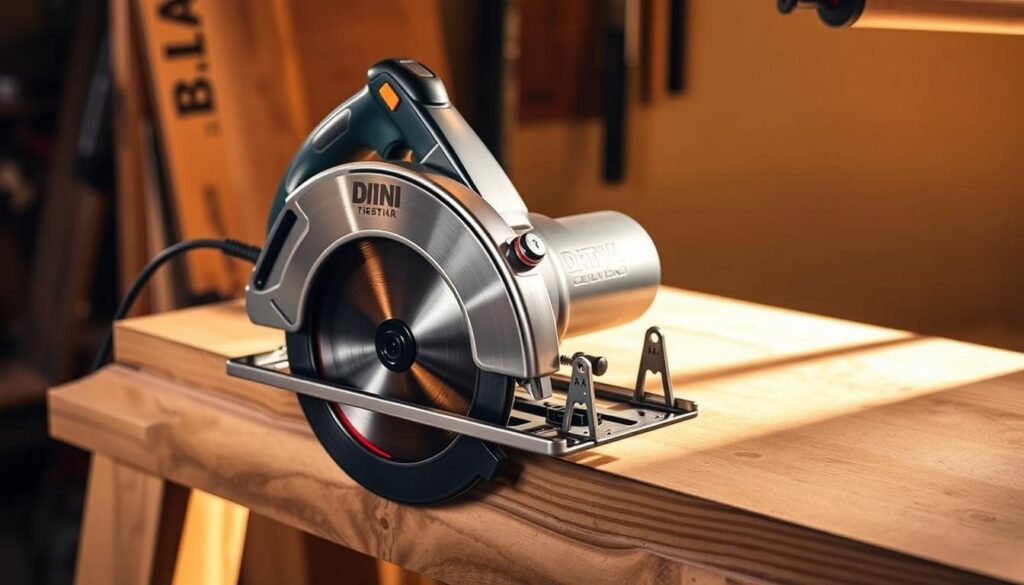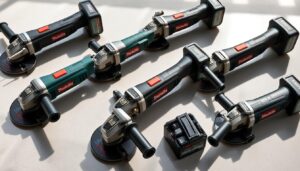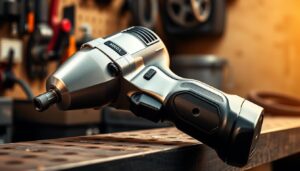Are you tired of struggling with cumbersome power tools that limit your creativity in DIY projects? You’re not alone. Many DIY enthusiasts face the challenge of finding the right balance between power and portability.
Compact and versatile, circular saws have become increasingly popular among DIY enthusiasts. They offer impressive cutting capacity in a convenient handheld package, making them ideal for a variety of tasks.
With a motor-driven blade that spins at high speeds, typically 4,000 RPM or higher, these tools provide the performance needed for demanding DIY projects. Whether you’re working with wood or other materials, a reliable circular saw is an essential addition to your toolkit.
Key Takeaways
- Discover the most suitable power tools for your DIY needs.
- Learn about the key features that make a circular saw effective.
- Explore the benefits of using compact saws for various projects.
- Understand the importance of performance in a circular saw.
- Find out how to choose the best tool for your specific DIY requirements.
Understanding Mini Circular Saws
Mini circular saws have revolutionised the way DIY enthusiasts approach various projects. These tools are designed to provide precision and control, making them ideal for a range of tasks.
What Makes Mini Circular Saws Different
Mini circular saws are distinguished from their standard counterparts primarily by their compact size and reduced blade diameter, typically ranging from 85mm to 115mm. In comparison, standard circular saw blades range from 165-190mm. This reduction in size affects the cutting depth; for instance, 115mm mini circular saws can cut down to around 40mm at 90°, while the more compact 85mm versions can cut to around 25mm.
Despite their smaller size, mini circular saws are designed for one-handed operation, making them more manoeuvrable and easier to control for precise cutting tasks in tight spaces.
Benefits for DIY Projects
The benefits of using mini circular saws for DIY projects are numerous. They excel at making straight cuts in sheet materials like plywood, MDF, and laminate flooring, making them perfect for home renovation and furniture-making projects. Their reduced weight (typically 1.5-4kg) makes them less fatiguing to use over extended periods.
As “The right tool can make all the difference in a project”, mini circular saws are a valuable addition to any DIY enthusiast’s toolkit, offering a convenient and efficient cutting solution.
- Compact size allows for one-handed operation and increased manoeuvrability.
- Ideal for precise cutting tasks in tight spaces.
- Capable of making straight cuts in various sheet materials.
- Reduced weight minimises fatigue during extended use.
Key Features to Consider When Buying a Mini Circular Saw
To make an informed decision when buying a mini circular saw, it’s crucial to understand the key features that distinguish one model from another.
Power Source: Corded vs Cordless
One of the primary decisions you’ll need to make is whether to opt for a corded or cordless mini circular saw. Corded models offer unlimited runtime and consistent power, making them suitable for prolonged use. On the other hand, cordless models provide greater portability and convenience, allowing you to work without being tethered to a power source.
Blade Size and Cutting Depth
The size of the blade significantly impacts the saw’s cutting capability. Larger 115mm blades can make deeper cuts, typically around 40mm, whereas 85mm blades are generally limited to cuts of about 25mm. However, smaller blades often offer greater precision for detailed work.
Speed and Power Ratings
The power rating of a mini circular saw, whether it’s corded or cordless, affects its performance. For corded saws, power is measured in amperage, with 15 amps being a common rating. Cordless saws are rated by battery voltage, ranging from 12 to 60 volts. The speed, measured in RPM (revolutions per minute), also directly impacts cutting efficiency, with higher speeds typically resulting in cleaner cuts.
Top Mini Circular Saws for DIY Enthusiasts
As a DIY enthusiast, you’re likely no stranger to the importance of a reliable mini circular saw in your toolkit. With so many options available, we’ve put these saws through a rigorous testing process to bring you the best.
How We Tested and Selected
Our comprehensive testing involved evaluating each mini circular saw across multiple parameters, including cutting performance, ease of use, build quality, battery life for cordless models, and overall value for money. We tested each saw on various materials commonly used in DIY projects.
We assessed both straight cuts and bevel capabilities where available, and ergonomics played a crucial role in our evaluations due to the one-handed operation design of mini circular saws.

Our Rating Criteria
Our final selections represent the best balance of performance, features, durability, and value, with options to suit different budgets and project requirements. Safety features were also carefully assessed, including blade guards and lock-off switches.
| Criteria | Weightage | Description |
|---|---|---|
| Cutting Performance | 30% | Ability to make clean cuts through various materials |
| Ease of Use | 20% | Ergonomics, comfort, and balance during operation |
| Build Quality | 20% | Durability and construction of the saw |
| Safety Features | 15% | Presence of safety features like blade guards |
| Value for Money | 15% | Balance between price and performance |
Best Overall Mini Circular Saw: DeWalt DCS571N XR Brushless Compact Circular Saw
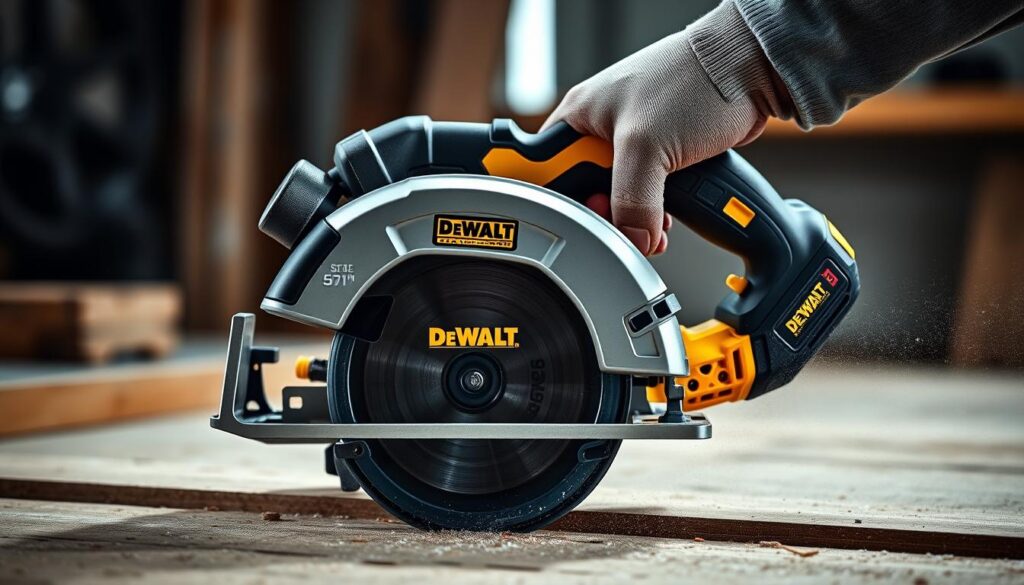
Overview
DeWalt’s DCS571N XR Brushless Compact Circular Saw is a powerhouse that combines precision, power, and durability, making it an ideal choice for both professionals and DIY enthusiasts. This saw is part of DeWalt’s renowned 18V XR battery system, known for its reliability and performance.
Pros
The DeWalt DCS571N stands out due to its exceptional combination of power and precision. It features a powerful 18V XR battery system paired with a brushless motor, delivering impressive efficiency and extended runtime. The saw offers a class-leading cutting depth of 38mm at 90° and 25mm at 45°, making it versatile for most DIY cutting tasks. Additionally, its ergonomic design includes a comfortable rubberised grip that reduces vibration and user fatigue.
Cons
While the DeWalt DCS571N is priced at the higher end of the mini circular saw market, its superior performance and durability justify the cost. However, users should be aware that the saw’s weight, at 2.5kg, might be considered heavy by some, although it provides stability during use.
Features
The DeWalt DCS571N features a 115mm blade spinning at up to 4,500 RPM, allowing for precise cuts in various materials. Its brushless motor enhances efficiency and prolongs the lifespan of the saw. The saw’s design allows for bevel cuts up to 45°, adding to its versatility. Compatibility with DeWalt’s extensive 18V battery system is another significant advantage, offering users flexibility and convenience.
Best Value Corded Mini Circular Saw: Einhell TC-CS Corded Mini Circular Saw Kit
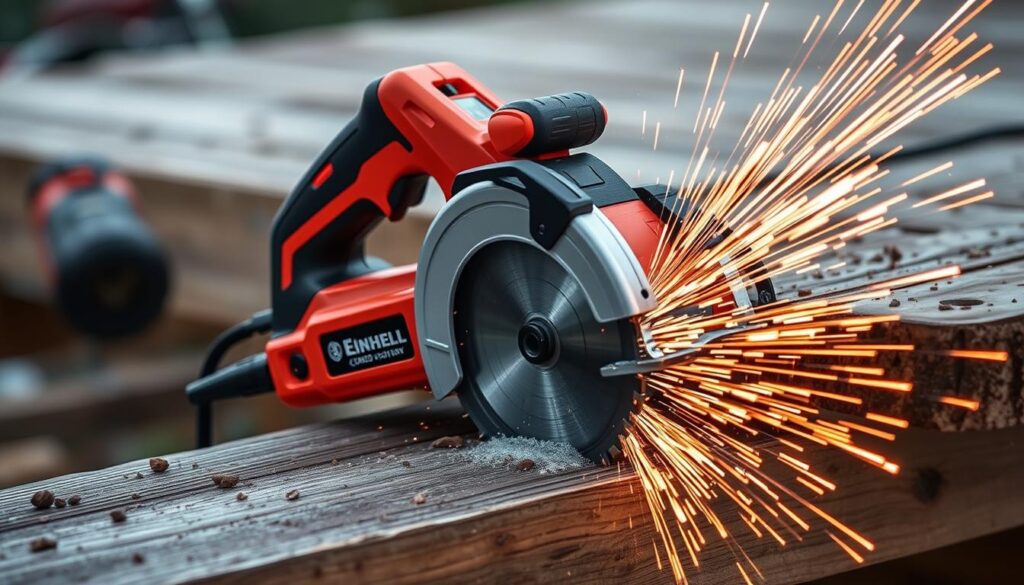
Overview
The Einhell TC-CS corded mini circular saw kit is a valuable tool for DIY enthusiasts, offering exceptional value and reliable performance. Weighing just 2kg, it’s easy to manoeuvre and control.
Pros
This saw has several advantages, including its lightweight design and impressive cutting power. The 450W motor spins the 85mm blade at 6,000 RPM, making quick work of plywood, MDF, and thin timber. Additionally, the kit includes valuable accessories like a parallel guide and allen keys.
Cons
One limitation of the Einhell TC-CS is its inability to cut at an angle, restricting its use to 90-degree cuts.
Features
The Einhell TC-CS features an intuitive depth guide, allowing for precise control over the cutting depth from 0-23mm. The saw also includes a sturdy carrying case, enhancing portability and storage. Its corded design ensures consistent power, making it suitable for extended cutting sessions.
Best Cordless Mini Circular Saw: Ryobi 18V ONE+ Cordless 150mm Circular Saw
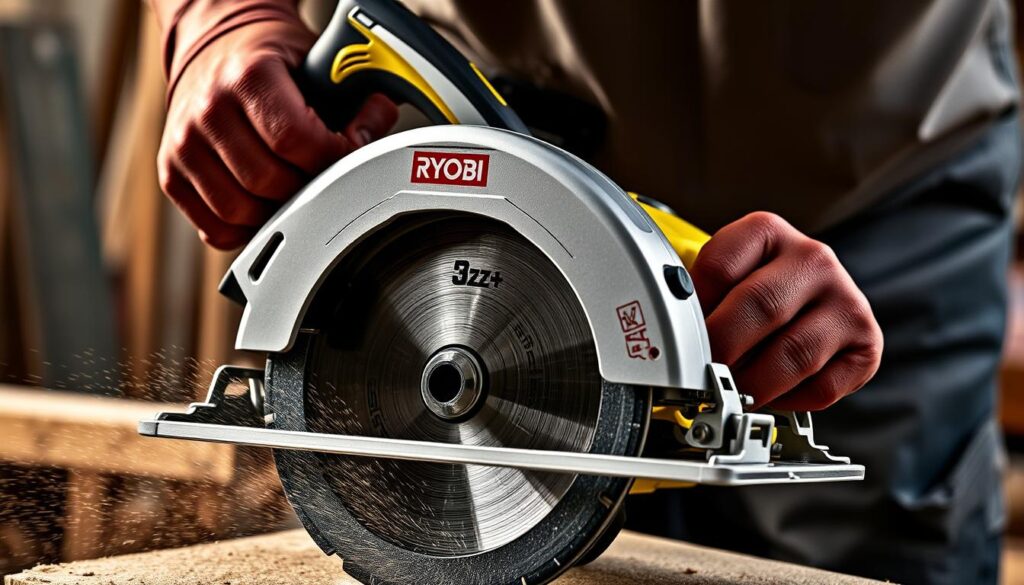
Overview
The Ryobi18V ONE+ Cordless150mm Circular Saw offers an excellent balance of performance, portability, and value, making it our top choice for cordless mini circular saws. It is part of Ryobi’s extensive ONE+ battery system, providing versatility for users who already own other Ryobi tools.
Pros
The Ryobi saw is surprisingly compact and lightweight, weighing just over 2kg without the battery pack. It offers a cutting depth of 45mm at 90° and 32mm at 45°, handling most DIY cutting tasks with ease. The battery performance is exceptional, with a 2.5Ah battery cutting up to 36 metres of 13mm plywood on a single charge.
Cons
While the Ryobi18V ONE+ is highly portable, its performance is dependent on the battery life, which may not be sufficient for heavy-duty or prolonged use without recharging.
Features
The saw features helpful depth and angle adjustment scales, making precise setting changes quick and intuitive. This enhances accuracy for DIY users of all experience levels. The Ryobi18V ONE+ Cordless150mm Circular Saw is an excellent choice for those seeking a reliable, cordless circular saw.
Best Lightweight Option: Makita HS301DZ Mini Circular Saw
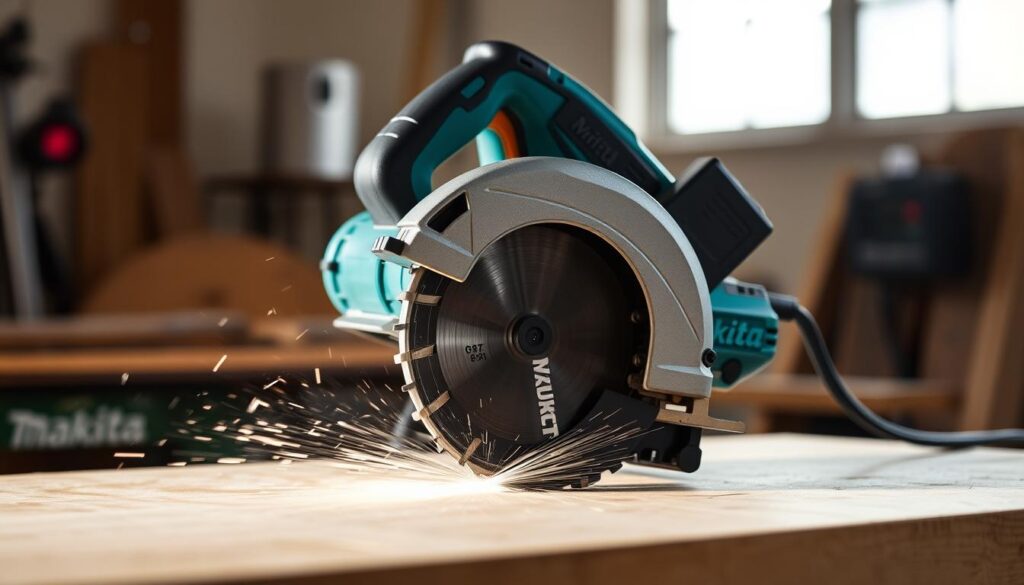
Overview
The Makita HS301DZ Mini Circular Saw is part of Makita’s respected 10.8V range, known for its balance of power and portability. Weighing just 1.7kg (excluding battery), it’s exceptionally easy to handle for extended periods.
Pros
Lightweight and Ergonomic Design: The rubberised handle and one-handed lock system provide excellent control and safety. Precision Cutting: With a maximum cutting depth of 25.5mm at 90°, it’s ideal for thin sheet materials like plywood and MDF.
The Makita HS301DZ is also part of a larger 10.8V system, making it a versatile addition for those already invested in Makita’s range.
Cons
It’s worth noting that the Makita HS301DZ is sold as a “bare tool,” meaning it doesn’t come with a battery or charger. While this is excellent value for existing Makita 10.8V users, it requires an additional purchase for those new to the platform.
Features
The saw’s compact form factor and renowned Makita build quality make it perfect for precision cutting in tight spaces. The ergonomic design ensures comfort during use, reducing fatigue.
Best for Precision Cutting: Bosch Professional GKS 12 V-26 Cordless Circular Saw
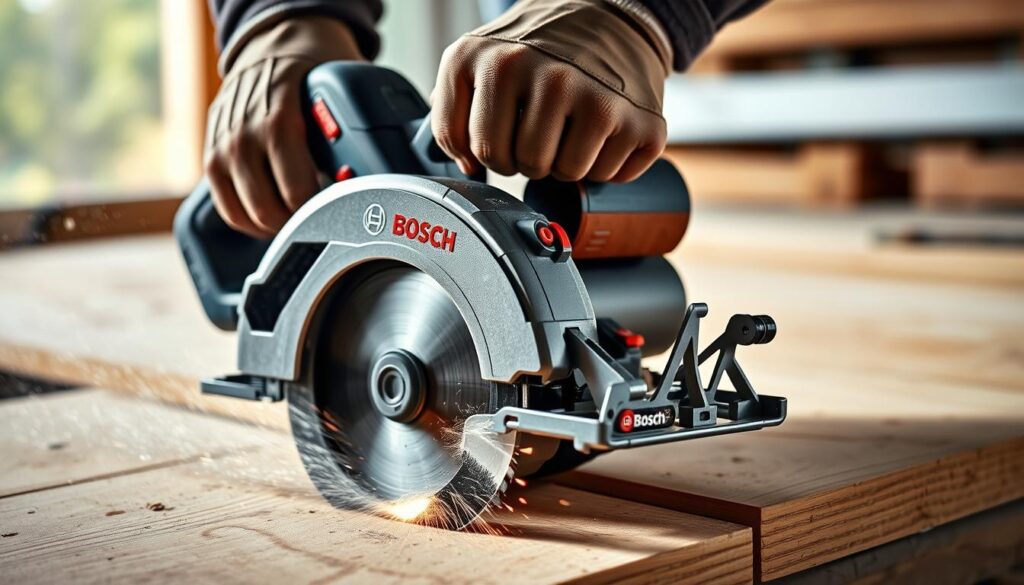
Overview
Precision cutting is made easy with the Bosch Professional GKS12 V-26 Cordless Circular Saw. This saw is powered by Bosch’s excellent 12 Volt professional system, offering the same level of power as their bigger 18 Volt battery but in a much smaller package.
Pros
The Bosch Professional GKS12 V-26 stands out as the premier choice for precision cutting, combining German engineering excellence with thoughtful design features that enhance accuracy. It utilises Bosch’s innovative 12V professional battery system, delivering impressive power in a remarkably compact package. The saw is exceptionally lightweight at just 1.4kg, making it easy to control for intricate cutting tasks.
Cons
While the Bosch GKS12 V-26 is a powerful tool, its cutting depth is limited to 26.5mm at 90° and 17mm at 45°, which may not be sufficient for thicker materials.
Features
The saw includes Bosch’s precision guide system and laser marking technology, allowing for exceptionally accurate straight cuts and consistent results. With an 85mm blade providing excellent visibility of the cutting line, this cordless circular saw is perfectly suited for precise work on sheet materials.
Key Features:
– Powered by Bosch’s 12V professional system
– Maximum cutting depth of 26.5mm at 90°
– Includes precision guide system and laser marking technology
– Weighs only 1.4kg for easy handling
Best Budget Option: Hychika Mini Circular Saw

Overview
The Hychika Mini Circular Saw offers exceptional value without breaking the bank. It’s a lightweight and quiet tool, ideal for trimming tiles and laminate flooring, making it a versatile addition to any DIY toolkit.
Pros
The Hychika Mini Circular Saw boasts several key advantages. It features a 750W motor that provides ample power for cutting through various materials, including wood, plastic, and soft metals. The integrated laser guide enhances accuracy, while the universal vacuum attachment ensures a cleaner workspace. Additionally, the saw comes with three blades for different materials and a parallel guide for straight cuts.
Cons
While the Hychika Mini Circular Saw is a great value, it’s not designed for heavy-duty applications. It’s best suited for smaller DIY projects and precision work rather than cutting through thick or large pieces of material.
Features
The Hychika Mini Circular Saw is equipped with a range of features that enhance its usability and performance. The push-button spindle lock makes changing blades easy, and the barrel grip provides a comfortable hold. You can purchase this versatile tool from StockMustGo, ensuring you get a genuine product with potential warranty benefits.
Best for Versatility: Worx WX527 Compact Circular Saw
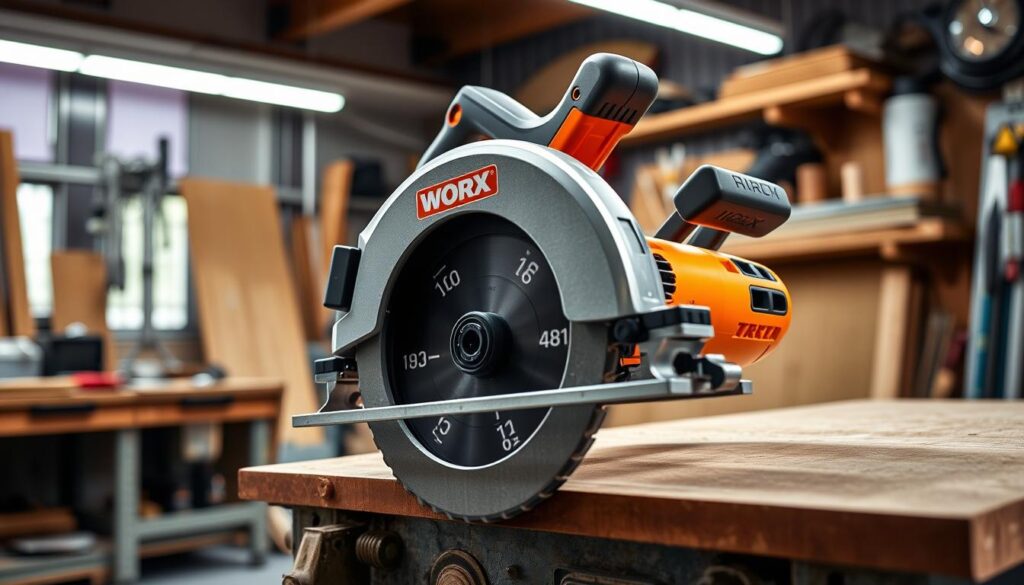
Overview
The Worx WX527 Compact Circular Saw is ideal for DIY enthusiasts due to its multi-material cutting capability. Powered by a 20V Max battery, it offers cordless convenience without compromising on power.
Pros
This cordless circular saw comes with three different blades for wood, metal, and tile, making it a versatile tool for various projects. The adjustable cutting depth gauge is user-friendly, featuring bright and easy-to-read markings. Additionally, it comes in a high-quality storage case, keeping the saw and accessories organised.
Cons
While the Worx WX527 is highly versatile, some users might find the battery life could be longer for extensive projects. However, the ability to share batteries across Worx tools mitigates this issue.
Features
The Worx WX527 Compact Circular Saw boasts a powerful 20V MAX battery system, allowing for cordless operation. Its multi-material cutting capability, coupled with three specialised blades, makes it suitable for a wide range of DIY tasks. The saw’s design includes an adjustable cutting depth gauge, enhancing its versatility and user experience.
Understanding Circular Saw Blade Types for DIY Projects
To get the most out of your mini circular saw, it’s essential to understand the different types of blades available. The right blade can make a significant difference in the quality of your cuts and the longevity of your tool.
Wood Cutting Blades
Wood cutting blades are designed for general cutting and fine finishing work. They typically feature between 18-24 teeth for rough cuts and up to 40+ teeth for smoother finishes. Using the right wood cutting blade can help you achieve professional-looking results in your DIY projects.
Metal Cutting Blades
Metal cutting blades are specially designed with hardened teeth to cut through metal without overheating. They are ideal for DIY projects involving aluminium, copper, or thin steel sheets. When working with metal, it’s crucial to use the correct blade to ensure safe and efficient cutting.
Multi-Material Blades
Multi-material blades offer versatility for DIY enthusiasts who work with various materials. Featuring carbide tips and special tooth geometries, these blades can handle wood, plastic, thin metals, and even ceramic tiles. When selecting a multi-material blade, ensure it matches your saw’s specifications for safe and effective operation.
When choosing a blade for your mini circular saw, consider the material you’ll be cutting and the desired finish. Matching the blade to your specific needs will help you achieve clean, efficient cuts and extend the life of your tool.
- Choose the right blade type for your project to ensure clean, efficient cuts.
- Match the blade diameter and arbor size to your mini circular saw’s specifications.
- Consider the number of teeth on the blade to achieve the desired finish.
Safety Tips When Using Mini Circular Saws
When operating mini circular saws, safety should be your top priority to avoid serious injuries. These powerful tools can cause significant harm if not used correctly.
Personal Protective Equipment
It’s essential to wear the correct personal protective equipment whenever operating power tools. This includes safety glasses to protect against flying debris, ear protection to prevent hearing damage, and a dust mask to avoid inhaling harmful particles. Although mini circular saws are relatively quiet, ear protection is still necessary.
- Safety glasses to protect your eyes from debris
- Ear protection to prevent hearing damage
- Dust mask to avoid inhaling harmful particles
Proper Handling Techniques
Proper handling techniques are crucial for safe operation. Ensure the saw is firmly gripped with one hand, keeping your other hand away from the cutting path. Always allow the blade to reach full speed before beginning your cut. Never remove the blade guard or other safety features, as they are designed to protect you from accidental contact with the spinning blade.
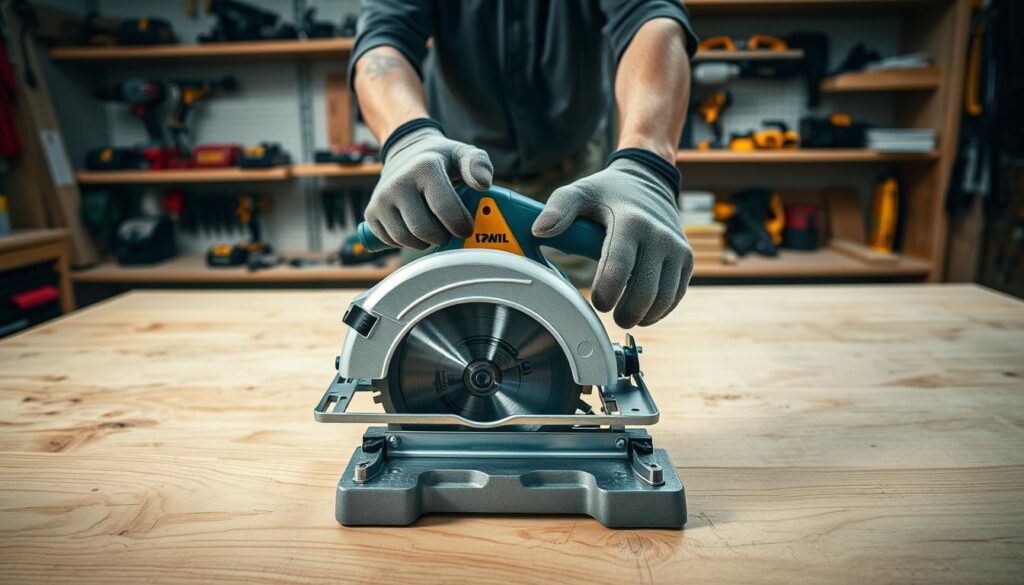
Workspace Considerations
Your workspace should be well-lit, free from clutter, and feature proper support for the material being cut. Ensure the workpiece is securely positioned so it doesn’t shift during cutting, potentially causing the blade to bind or kick back. A well-organized workspace is key to safe and effective use of mini circular saws.
By following these safety guidelines, you can minimize the risks associated with using mini circular saws and ensure a safe working experience.
Maintenance and Care for Your Mini Circular Saw
Maintaining your mini circular saw is vital for extending its lifespan and ensuring safety during operation. Regular maintenance not only enhances the tool’s performance but also prevents potential hazards.
Cleaning and Storage
After each use, it’s essential to clean your mini circular saw. Remove dust and debris from vents, blade housing, and moving parts using a soft brush or compressed air. Ensure the power source is disconnected or the battery is removed before cleaning. For cordless models, proper battery care is crucial; store batteries at room temperature and avoid complete discharge to maximise battery life. Store your saw in a dry, dust-free environment, ideally in its original case or a dedicated tool storage solution.
Blade Replacement and Care
Blade replacement is a critical aspect of maintaining your circular saw. Replace the blade when you notice decreased cutting efficiency, burn marks on cut materials, or visible wear on the blade teeth. To replace the blade, unplug the saw or remove the battery, press and hold the spindle lock, and use the included Allen key to undo the nut. Regularly inspect your blades for damage and store them properly to maintain their effectiveness.
| Maintenance Task | Frequency | Benefit |
|---|---|---|
| Clean saw and vents | After each use | Prevents overheating and damage |
| Inspect and replace blade | When necessary | Ensures clean cuts and safety |
| Store in dry environment | Ongoing | Prevents rust and corrosion |
By following these maintenance tips, you can ensure your mini circular saw remains a reliable tool in your DIY arsenal, providing consistent power and performance.
Conclusion
Investing in a mini circular saw can significantly elevate your DIY capabilities, offering a balance between power and portability. With a plethora of options available, there’s a mini circular saw to suit every budget and project requirement, from premium professional-grade models to affordable options for occasional home use.
When selecting the right mini circular saw, consider the balance between cutting depth, battery life for cordless models, and the types of materials you’ll be working with. For most DIY users at home, a versatile model like the DeWalt DCS571N or the value-focused Hychika Mini Circular Saw will provide the best combination of performance and affordability.
Whichever model you choose, remember that proper maintenance, appropriate blade selection, and adherence to safety guidelines will ensure your mini circular saw remains a reliable tool for years of productive DIY work.
